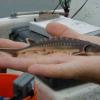You need to consider that looking for a tree that grows well in low light is like looking for a fish that does well without water. Realize that a tree expends energy into producing a trunk that does not photosynthesize, does not produce any food for the plant, in order to win the race for sunlight. It also escapes grazing mammals but not insects, birds, and climbing mammals, so the main reason for being a tree is to reach sunlight.
Gerald's suggestion of an understory tree is sound and many shrubs can be pruned to look like trees. We do it all the time in bonsai, my other major hobby besides native fish. Semi-aquatic shrubs such as buttonbush should work well. Buttonwood is used commonly in bonsai, but it is difficult to get the leaf reduction necessary to make it look like a tiny tree. Realize that trees and shrubs develop a tolerance for the low root oxygen associated with wet roots to win the competition for sunlight.
Many trees live as understory plants until a tree above dies, giving them the chance to win the race for sunlight, but these trees tend to be wide and squatty to get as much light to the leaves as possible. Their growth form is much different than that of mature trees. However, a young tree grown in full sunlight quickly develops the shape of a mature tree.
Bonsai are kept small primarily by root pruning and restricting the roots by pot size. Branch pruning in bonsai is focused on creating a shape in a young tree that looks like an old tree. There are dwarf varieties of trees that have the shape of the mature tree. For instance, I purchased a Peve Minaret bald cypress last spring that has fits that description. All of my bonsai bald cypress pots sit in water year-round. My wife grows black olive bonsai, Bucida spinosa, with the pot sitting in water. This is a small, spiny tree native to the Caribbean that is tolerant of low light like bald cypress. It is a tropical tree that does well in our greenhouse with drops to 45 degrees F at night during the winter, conditions similar for indoor-kept native fish.
You can probably get additional ideas by visiting a local bonsai club. You will probably get the best help from people who are used to growing small trees in unnatural situations and make them look like large trees.
Phil Nixon
Bonsai Society of Central Illinois Secretary
Tree insect entomologist, University of Illinois













